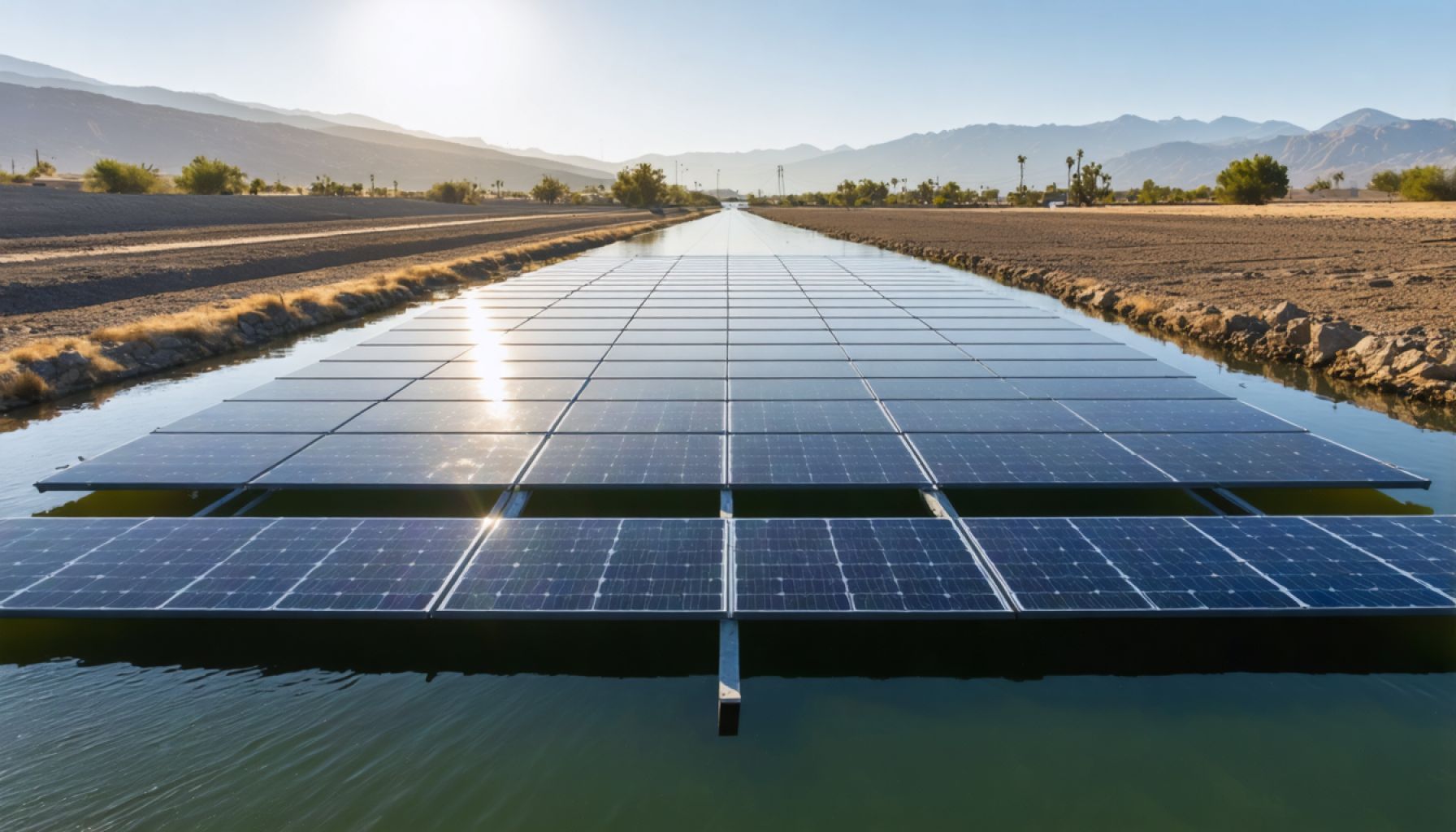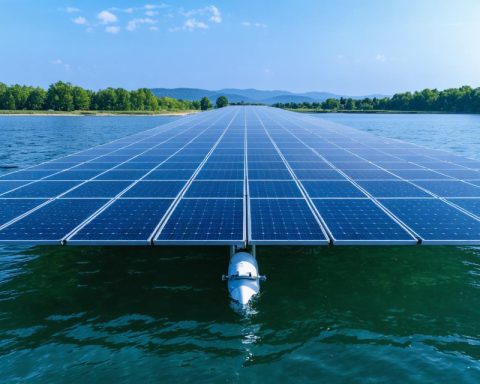- Green Energy Systems is transforming California’s canal network through the innovative “Solar Waves” system, which integrates solar panels to produce renewable energy.
- The Project Nexus initiative will cover over 4,500 miles of irrigation canals, generating up to 12 gigawatts of power while reducing water evaporation—a vital concern for drought-prone California.
- The “Solar Waves” design is scalable and cost-effective, created to reduce material costs and ease installation without traditional hardware, making it a compelling choice for sustainable ventures.
- Glen Carless, leading the project, emphasizes its adaptability, as the system can function over canals, on water surfaces, and in agrivoltaic settings, meeting Solar AquaGRID’s economic requirements.
- The $30 million trial, in collaboration with Turlock Irrigation District, underscores the potential for global application, positioning Green Energy Systems as a leader in renewable solutions.
Australian firm Green Energy Systems has catapulted into the limelight with their ingenious “Solar Waves” system, set to illuminate California’s vast canal network with renewable energy. The company has grabbed attention through Project Nexus, an ambitious Californian initiative championing sustainability by transforming over 4,500 miles of irrigation canals into potent energy generators. The project promises to weave solar panels into the fabric of these waterways, setting the stage for a grand energy renaissance.
Envision these canals snaking through the sun-drenched Californian landscape, their surfaces shimmering not just with reflected sunlight but with an array of sleek solar panels steadily generating 12 gigawatts of power. This monumental endeavor seeks to harness the dual benefits of covering water canals: it doesn’t just generate energy but also combats water evaporation—a critical resilience measure in a state often plagued by drought.
Green Energy Systems, headquartered in Sydney, has sewn innovation into every corner of the “Solar Waves” design, creating a scalable, plug-and-play solar solution. Here lies the beauty—their technology doesn’t merely install panels; it deploys them like an appliance, merging form and function into a seamless operation. With the elimination of cumbersome hardware like bolts and clamps, and slicing material costs in half, Solar Waves presents a compelling economic and environmental case.
Glen Carless, the visionary at the helm, elucidates that this is a system apart. Its retractable, pre-wired design makes it adaptable, whether spanning over canals, floating on their surfaces, or even resting in fields engaged in agrivoltaics—synergy in action. Thus, Solar Waves stands as the solitary contender meeting Solar AquaGRID’s stringent economic benchmarks, chosen out of sixty hopefuls to partner with the Turlock Irrigation District in this $30 million trial.
Imagine canals cradled under these solar canopies, conserving precious water while silently powering homes, businesses, and industries with clean energy. This venture is not merely about the deployment of technology; it’s a testament to visionary collaboration, with Green Energy Systems having invested over $20 million in researching and refining this bold solution.
As the sun rises over California, the message is clear: harnessing renewable energy is not just a dream but a tangible, scalable reality. Green Energy Systems is poised to make a sweeping change—not just for California, but potentially for arid regions globally. The Solar Waves system signifies a beacon of innovation, offering a sustainable and economically sound pathway to a greener future.
How Solar Waves Are Revolutionizing California’s Canals
Overview of Solar Waves by Green Energy Systems
The “Solar Waves” project by Green Energy Systems is a groundbreaking initiative transforming California’s extensive irrigation canals into renewable energy beacons. This effort, known as Project Nexus, aims to integrate solar technology with environmental sustainability by covering over 4,500 miles of canals with innovative solar panels. This project is designed not only to harness solar power but also to mitigate water evaporation—a vital intervention in drought-prone California.
Key Features and Specs of Solar Waves
– Scalability and Adaptability: The Solar Waves system is designed to be a versatile solution. Its retractable, pre-wired solar arrays can be deployed over canals, on water surfaces, or even on land for agrivoltaics, making it adaptable to various environments.
– Economic Efficiency: The design eliminates the need for traditional mounts such as bolts and clamps, significantly reducing material costs and simplifying installation.
– Power Generation: When fully implemented, these solar canopies aim to produce up to 12 gigawatts of power, contributing a substantial share to California’s renewable energy resources.
– Water Conservation: By shading the water channels, the system reduces evaporation, conserving water—a critical natural resource in areas experiencing water scarcity.
Real-World Use Cases and Impact
1. Energy Generation: The project is expected to supply clean energy to thousands of homes and businesses, significantly reducing carbon emissions.
2. Water Conservation: The shading provided by the solar panels can reduce water evaporation by up to 82%, as supported by studies from the University of California, Merced.
3. Economic Growth: By adopting this technology, regions can not only reduce energy costs but also leverage federal and state incentives for renewable energy implementations.
Market Forecast and Industry Trends
The global solar energy market is expected to grow from $223.3 billion in 2022 to $368.6 billion by 2030, according to a report by Allied Market Research. Innovations like Solar Waves are leading this surge by offering a dual-purpose solution that caters to the rising demand for sustainable energy while addressing water scarcity issues.
Reviews and Comparisons
Among the many solar solutions evaluated, Solar Waves stands out for its economic feasibility and minimal environmental impact. In contrast to traditional terrestrial solar farms, which often require significant land and resources, Solar Waves offers a low-impact solution utilizing existing canal infrastructure.
Challenges and Limitations
– Initial Investment: While operational costs may be lower, the initial investment for such large-scale implementations is substantial.
– Environmental Impact: Concerns about the impact on canal ecosystems require careful consideration and management to avoid disrupting local wildlife.
Actionable Recommendations
– Collaborative Ventures: Encourage partnerships between governments and technology providers to expand similar projects globally.
– Invest in Research: Continue research into material sciences and innovative designs to further reduce costs and improve efficiency.
– Public Awareness: Promote awareness campaigns highlighting the dual benefits of renewable energy and water conservation.
Conclusion
Green Energy Systems’ Solar Waves initiative offers an innovative solution to two pressing challenges: renewable energy generation and water conservation. Its scalable design, economic efficiency, and significant environmental benefits position it as a leader in sustainable technology. As California embraces this technology, it sets a precedent for other regions facing similar environmental challenges.
For more insights on renewable energy advancements, visit the U.S. Department of Energy website.


















